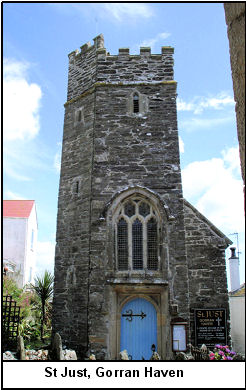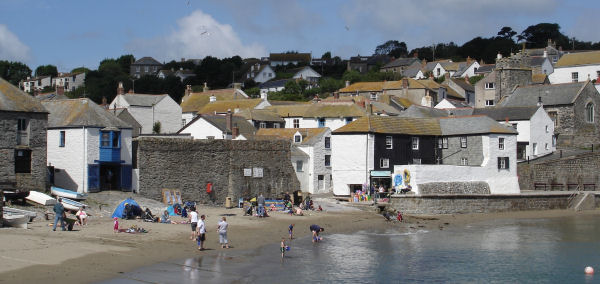

ABOVE ALL A CORNISHMAN
by Maureen Storey
This article was originally published in the August 2008 edition of Soul Search, the journal of The Sole Society
Like most people, as the days lengthen and grow warmer I begin to think of summer holidays. My favourite holiday destination is Cornwall and I have a particular affection for the tiny fishing village of Gorran Haven where Tony and I spent our honeymoon.
The parish of Gorran lies southwest of St Austell and boasts two ancient churches, one in each of its centres of occupation: the parish church, St Goran's, in Gorran Churchtown and St Just's, a little chapel of ease perched on the sea wall at Gorran Haven. Gorran Haven used to be known as Portheast, which is a corruption of Porth Just.
Although only a mile apart, in the past the inhabitants of the two villages lived very different lifestyles. Those in and around the Churchtown worked in agriculture and its allied trades, whilst, until the advent of tourism, boat building and fishing (and smuggling) were at the centre of the Haven's economy. By the nineteenth century, however, the two communities had one thing in common, their churches were in desperate need of repair.
By the 1860s most of the essential work had been done on St Goran's but St Just's was described as little more than a ruin, though part of it was still being used as a Sunday school and for occasional services. An early photograph shows that a section of its roof was missing and the east gable had collapsed. In 1869 these were the problems faced by the new vicar Charles Richard Sowell.
Charles was born in Penryn, CON, in about 1829, and was as far as we know the only child of Richard Bamfield Sowell, a draper, and his wife Loveday Toy. The family had by then been in the Penryn/Falmouth area for at least five generations and has been traced back as far as the marriage of Richard Sowell and Elizabeth Wilburne in 1684. Although we have very few details about them, the little we have suggests that they were middle class and affluent. Charles's grandfather Joseph Sowell appears in trade directories as a maltster and merchant, but may have been far wealthier than this suggests as he also had mining interests and was involved in Cornish politics. Young Charles was sent to study at Exeter College, Oxford, where he received his BA in 1852. He became a deacon in 1853 and was ordained in 1854. He served as a curate in St Austell from 1853 to 1855, then moved to become vicar of the parish of Paignton, DEV (1855-1857). From there he went to Northam, DEV (1857-1860), St Feock, CON (1860-1869) and then to Gorran.
Charles married Julia Trenery in 1853 and they had four children, Mary, Rosa, Richard and Walter, before Julia's premature death in 1865. Charles never remarried – from the census records it seems that after Julia's death his sister-in-law, Olivia Trenery, lived with the family to look after the children. In 1869 the family moved into the rectory in Gorran Churchtown, and Charles began work in the parish. In addition to the normal parochial duties, his first major task was to oversee the completion of the renovations at St Goran's. Once this was finished he was able to turn his attention to St Just, which by then had been declared unsafe – the roof was beyond repair, the remains of the east gable were tilting inwards, the glass in the windows had shattered and the stairs were giving way.
The restoration, which was completed in 1885, cost what was then the massive sum of nearly £600, a sum that had to be raised by the vicar, not an easy task in an impoverished Cornish parish. The work was undertaken by Pier St Aubyn, who is notorious for ruining half the churches in Cornwall with his too ruthless renovations, although in Gorran Haven at least he is considered to have done a good job. No record was kept of what was actually done during the building work and it's now impossible to detect the joins between new and old masonry.

During Charles’s time in Gorran not only were the churches renovated, but in 1877 a new school was built for the children of the parish – at the turn of the century its average attendance was 120. It was fondly recorded that on cold days the vicar's daughter 'Miss Sowell' provided cups of tea and hot soup to supplement the children's lunch.
Charles remained the vicar of Gorran until his death in 1903, a ministry of 34 years. He is commemorated not only on his gravestone in the churchyard but also by a plaque on the church organ which reads 'To the glory of God and in affectionate memory of Charles Richard Sowell for 34 years vicar of this parish.'
Charles's son Richard also became a vicar. He graduated from St John's College, Cambridge, in 1884 and served in several Cornish parishes. In 1893 he married Alice Eyres and they had one son, Arthur Donald, who was born in 1895. In 1909 Richard became the vicar of St Kea, CON, and he stayed there until his death in 1934. His son, Lt Arthur Sowell, Duke of Cornwall's Light Infantry, was killed in France in 1916 during the battle of the Somme.
We know less about Charles's other children. Walter married Emily Blackett in London in 1896 and in 1901 was working in London in the publishing industry. As far as we know, they had no children. Rosa married in 1896, though we do not yet know her husband's identity, while Mary remained a spinster and died in Cornwall in 1936.
As so often happens we've been able to compile an outline of Charles's life but are left with very little idea of his character. The nearest thing we have to a character reference for him comes from a letter of 1855 written by Rev. Peter Holmes, one of his former teachers, who describes Charles thus, 'He is a very good fellow, rather clever and above all a Cornishman.'
